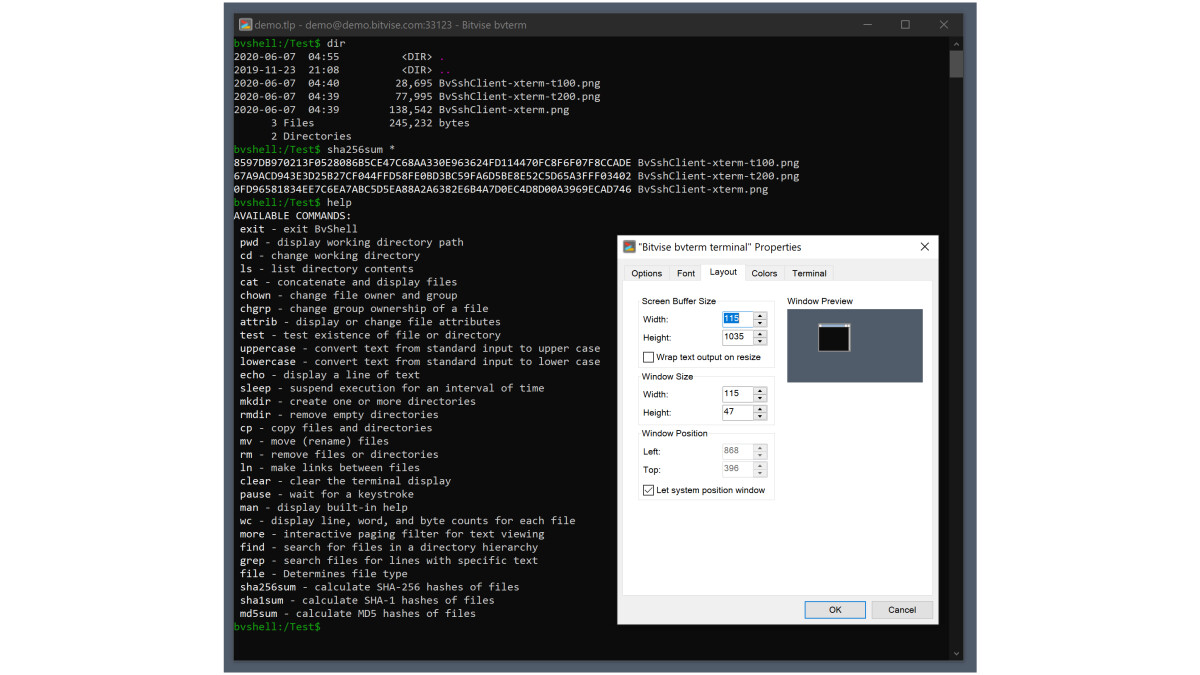

- #Bitvise ssh client graphical mode full
- #Bitvise ssh client graphical mode verification
- #Bitvise ssh client graphical mode windows
In the graphical SSH Client that has access to the keypair, use the Client key manager to export the full keypair into a file. There are a number of ways an authentication keypair can be passed to the SSH Client when it's running under a different account:

#Bitvise ssh client graphical mode windows
Like with host key verification, when the SSH Client is run unattended under a different Windows account than when the Client is used interactively, it cannot access authentication keypairs that are stored in a different Windows user's registry.
#Bitvise ssh client graphical mode verification
Otherwise, if the unattended client negotiates a different host key algorithm than the graphical client, host key verification may fail because the server will be presenting a different host key. If the server has multiple host keys, make sure that the unattended client has access to information about all of the host keys that the server might present. -hostKeyFp=.: Specifies a SHA-256, Bubble-Babble, or MD5 fingerprint of a host key to trust.-hostKeyFile=.: Specifies a file in which one or more host keys are stored.A host key or its fingerprint can be passed to any instance of the SSH Client - graphical or command line - using the following command line parameters:.Find the host key, right click it, and select Copy to profile.Open the Host key manager interface from the Login tab of the SSH Client.Open the profile using the graphical Bitvise SSH Client.If you have a host key that is trusted in the Windows registry, and you want to copy it to a profile: A host key can also be stored in a Bitvise SSH Client profile, and will then be trusted for the server connected to with that profile, regardless of the Windows logon session in which the connection occurs.All aspects of the SSH Client will then be able to connect to that server and trust that host key, as long as they are run in a Windows logon session belonging to the same Windows user. When you connect to the server interactively using the graphical SSH Client, and manually verify the server's host key, the SSH Client will store the host key in the Windows registry, but only for the currently logged on Windows user.There are a number of ways in which the SSH Client can be told what host keys the server might use that the Client can accept: Verification of the server's host key is essential to the security of the SSH session, so this step cannot be skipped. The most common issue when using Bitvise SSH Client non-interactively occurs when the client is run under a different Windows account than was previously used interactively, and the client has no way to verify the server's host key. This will retry an upload a default number of times, or until it succeeds and record all output with timestamps, in log files of the form C:\Dir\Log-(.).log. Log -tcxo C:\Dir\Log retry -f=100,101 sftpc -profile=C:\Dir\Profile.bscp cd /dir put *.txt Use the log utility to record the output of an SSH client session, another program, or a command script.įor help, run either of these commands without parameters.Use the retry utility to repeat an SSH client session, another program, or a command script.For help, run each of the clients as follows:īitvise SSH Client also includes utilities retry and log: Bitvise SSH Server.)Įach of the above clients supports a large variety of command line parameters. (Requires an SSH server that supports the SSH Public Key Subsystem e.g. spksc allows command-line management of client authentication keypairs configured for a user at an SSH server.stermc provides a console-based terminal shell.In addition, the following clients also offer a command line interface, but are usually used interactively: See also our page about running stnlc as a service. Use stnlc for unattended port forwarding/tunneling.Use sexec for remote command execution.Use sftpc for unattended file transfers.Bitvise SSH Client comes with several command line SSH clients that can be run unattended from other programs, or from the Windows Task Scheduler:


 0 kommentar(er)
0 kommentar(er)
